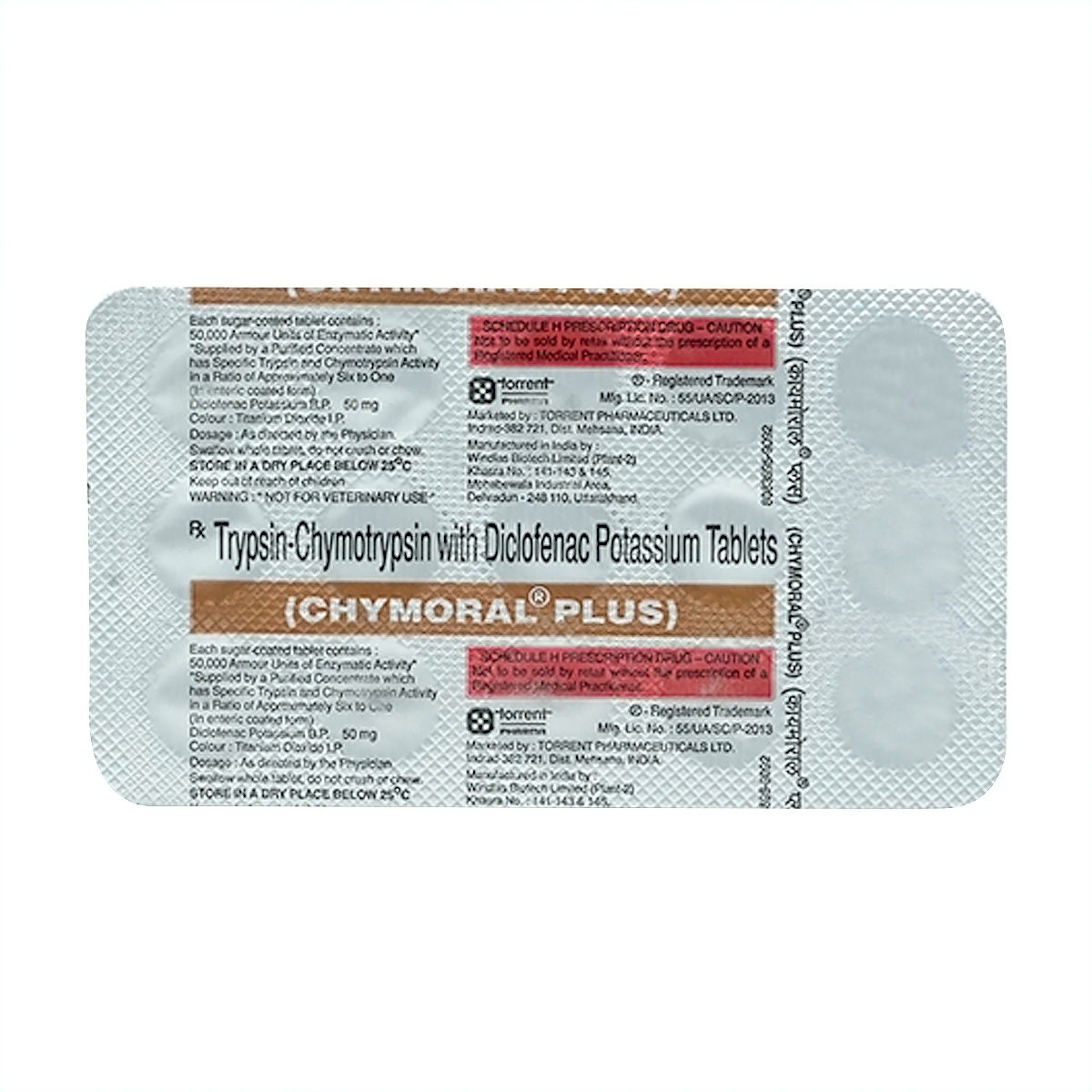DICLOFENAC POTASSIUM+TRYPSIN CHYMOTRYPSIN
About
DICLOFENAC POTASSIUM+TRYPSIN CHYMOTRYPSIN is a combination medicine used to relieve pain and inflammation associated with osteoarthritis, rheumatoid arthritis, ankylosing spondylitis, muscle pain, bone and joint pain. Pain is a symptom triggered by the nervous system, causing uncomfortable sensations in the body. Arthritis, also known as joint inflammation, is the tenderness and swelling of the joints. Symptoms include swelling, pain, and stiffness.
DICLOFENAC POTASSIUM+TRYPSIN CHYMOTRYPSIN contains Diclofenac potassium and Trypsin chymotrypsin. Diclofenac potassium works by blocking the effect of chemical messengers that cause pain and inflammation. Trypsin chymotrypsin breaks down the abnormal proteins at the site of inflammation, thereby reducing swelling and inflammation. Together, DICLOFENAC POTASSIUM+TRYPSIN CHYMOTRYPSIN provides relief from pain and inflammation.
You are advised to take DICLOFENAC POTASSIUM+TRYPSIN CHYMOTRYPSIN for as long as your doctor has prescribed it for you, depending on your medical condition. In some cases, you may experience common side-effects such as nausea, vomiting, stomach pain, loss of appetite, indigestion, and diarrhoea. Most of these side effects do not require medical attention and will resolve gradually over time. However, you are advised to talk to your doctor if you experience these side effects persistently.
Consult your doctor if you are pregnant or breastfeeding. DICLOFENAC POTASSIUM+TRYPSIN CHYMOTRYPSIN may cause drowsiness and dizziness, so drive with caution. DICLOFENAC POTASSIUM+TRYPSIN CHYMOTRYPSIN is not recommended for children as safety and efficacy have not been established. Avoid consuming alcohol with DICLOFENAC POTASSIUM+TRYPSIN CHYMOTRYPSIN as it could lead to increased drowsiness and dizziness; it might also increase the risk of stomach bleeding. Keep your doctor informed about your health condition and medicines to rule out any interactions.
Uses of DICLOFENAC POTASSIUM+TRYPSIN CHYMOTRYPSIN
Medicinal Benefits
DICLOFENAC POTASSIUM+TRYPSIN CHYMOTRYPSIN is a combination of two drugs, namely: Diclofenac potassium and Trypsin chymotrypsin. DICLOFENAC POTASSIUM+TRYPSIN CHYMOTRYPSIN is used to relieve pain and inflammation associated with osteoarthritis, rheumatoid arthritis, ankylosing spondylitis, muscle pain, bone and joint pain. Diclofenac potassium is an NSAID (Non-Steroidal Anti-Inflammatory Drug) which works by blocking the effect of chemical messengers called prostaglandins by inhibiting cyclooxygenase (COX) enzymes, thereby reduces mild to moderate pain and inflammation at the injured or damaged site. Trypsin chymotrypsin is a combination of enzymes. It breaks down the abnormal proteins at the site of inflammation, thereby reduces swelling and inflammation by increasing the blood supply at the affected area. Together, DICLOFENAC POTASSIUM+TRYPSIN CHYMOTRYPSIN provides relief from pain and inflammation.
Directions for Use
Storage
Side Effects of DICLOFENAC POTASSIUM+TRYPSIN CHYMOTRYPSIN
- Nausea
- Vomiting
- Stomach pain
- Diarrhoea
- Indigestion
- Loss of appetite
In-Depth Precautions and Warning
Drug Warnings
Do not take DICLOFENAC POTASSIUM+TRYPSIN CHYMOTRYPSIN if you are allergic to any of its contents; if you have/had severe heart problems, stomach ulcer or perforation, bleeding problems such as bleeding from the stomach, intestine or brain, bypass surgery, heart attack, blood circulation problems, or inflammation of intestines. Inform your doctor if you have/had high blood pressure, heart problems, high cholesterol, diabetes, asthma, angina, bowel problems, blood clotting disorder, a habit of smoking, liver or kidney problems. Consult your doctor if you are pregnant or breastfeeding. Stop taking DICLOFENAC POTASSIUM+TRYPSIN CHYMOTRYPSIN and consult your doctor immediately if you have stomach pain or any signs of bleeding in the intestine or stomach, such as blood in stools.
Drug Interactions
Drug-Drug Interactions: DICLOFENAC POTASSIUM+TRYPSIN CHYMOTRYPSIN may interact with pain killers (aspirin), anti-coagulant (warfarin, coumadin, heparin, clopidogrel), anti-depressant (duloxetine, lithium), antibiotics (chloramphenicol).
Drug-Food Interactions: No interactions found/established.
Drug-Disease Interactions: Inform your doctor if you have/had stomach ulcer or perforation, bleeding problems, bypass surgery, heart attack, blood circulation problems, inflammation of intestines, anaemia, heart, kidney or liver problems.
Drug-Drug Interactions Checker List:
Safety Advice

Alcohol
unsafeAvoid consumption of alcohol while taking DICLOFENAC POTASSIUM+TRYPSIN CHYMOTRYPSIN as it may increase drowsiness. It can also increase the risk of stomach bleeding.

Pregnancy
cautionConsult your doctor if you are pregnant; your doctor will prescribe only if the benefits outweigh the risks.

Breast Feeding
cautionConsult your doctor if you are breastfeeding; your doctor will decide whether DICLOFENAC POTASSIUM+TRYPSIN CHYMOTRYPSIN can be taken by breastfeeding mothers or not.

Driving
cautionDICLOFENAC POTASSIUM+TRYPSIN CHYMOTRYPSIN may cause dizziness and drowsiness. Do not drive or operate machinery unless you are alert.

Liver
cautionDose adjustment may be needed in patients with liver impairment. Please consult your doctor if you have a liver impairment or any concerns regarding this.

Kidney
cautionDose adjustment may be needed in patients with kidney impairment. Please consult your doctor if you have kidney impairment or any concerns regarding this.

Children
unsafeDICLOFENAC POTASSIUM+TRYPSIN CHYMOTRYPSIN is not recommended for children as safety and effectiveness have not been established.
Habit Forming
Diet & Lifestyle Advise
- Exercising regularly helps in muscle stretching so that they are less likely to spasm, tear and sprain. Mild exercises such as jogging and walking are helpful for muscle stretching.
- Massages can also be helpful.
- Avoid freezing and hot temperatures.
- Rest well, get plenty of sleep.
- To avoid developing pressure sores, change your position at least every two hours.
- Hot or cold therapy can help treat muscle spasms. Apply an ice-pack or hot-pack on the muscle for 15-20minutes.
- Stay hydrated, drink plenty of water.
- Avoid smoking and alcohol consumption.
Patients Concern
Disease/Condition Glossary
Pain: Pain is a symptom triggered by the nervous system, causing uncomfortable sensations in the body. Pain may be dull or sharp; it might be constant or may come and go. The tolerance level of pain might vary from person to person. Pain can be generalized (overall body aches) or localized (affecting a specific area of the body). The common causes of pain include headache, muscle strain, cramps, cuts, bone fractures, and arthritis.
Osteoarthritis: It is a joint disease in which the two ends of the joints come together due to the breakdown of a protective covering called cartilage. Due to the absence of this protective covering, the joints rub against each other, leading to pain and stiffness. Symptoms include pain, stiffness, inflammation and tenderness.
Rheumatoid arthritis: It is an auto-immune disease (the body's immune system attacks its tissue), leading to joint pain and damage. Symptoms of rheumatoid arthritis include pain, swelling, stiffness, deformities and loss of joint function.
Ankylosing spondylitis: It causes pain and stiffness in the spine. The pain generally starts in the lower back and can spread to the neck, damaged joints, or other body parts. Ankylosing spondylitis symptoms include decreased flexibility which usually leads to a hunched-forward posture, pain in the back and joints.
FAQs
DICLOFENAC POTASSIUM+TRYPSIN CHYMOTRYPSIN is used to relieve pain and inflammation associated with osteoarthritis, rheumatoid arthritis, ankylosing spondylitis, muscle pain, bone and joint pain.
DICLOFENAC POTASSIUM+TRYPSIN CHYMOTRYPSIN contains Diclofenac potassium and Trypsin chymotrypsin. Diclofenac potassium works by blocking the effect of chemical messengers that cause pain and inflammation. Trypsin chymotrypsin breaks down the abnormal proteins at the site of inflammation, thereby reduces swelling and inflammation.
DICLOFENAC POTASSIUM+TRYPSIN CHYMOTRYPSIN is used to reduce and relieve pain and inflammation associated with osteoarthritis, rheumatoid arthritis, and ankylosing spondylitis. Arthritis is the tenderness and swelling in the joints.
Do not take any other medicines for pain relief such as NSAIDs along with DICLOFENAC POTASSIUM+TRYPSIN CHYMOTRYPSIN unless prescribed by the doctor as it might increase the risk of side effects.
Avoid exceeding the dose and duration advised by the doctor. DICLOFENAC POTASSIUM+TRYPSIN CHYMOTRYPSIN should not be taken for longer durations unless prescribed by the doctor.
Avoid taking DICLOFENAC POTASSIUM+TRYPSIN CHYMOTRYPSIN if you have ulcers in the stomach or intestines, bleeding problems, or heart problems. Talk to your doctor if you have any concerns.




